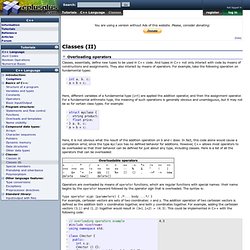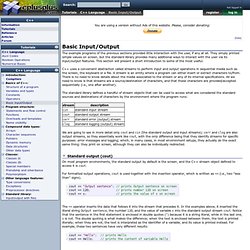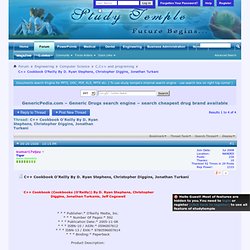

TBB Tutorial. This document gives a quick example of how to use Intel's Thread Building Blocks, by means of a simple example.

The example is available as a tarball here. The files are also available as syntax-highlighted HTML here (fatals.* and hrtime.h are elided). The latter portion of this document assumes the reader is following along using the syntax-highlighted Makefile and main.C. Installing Thread Building Blocks Log into the machine on which you would like to use TBB (this example uses an eight-processor x86-based machine called clover-01), and create a directory in which your TBB install will reside (you do NOT need root permissions on your machine). Get the open-source TBB tarball from (select the Commercial Aligned Release). Use tar to unpack the files: clover-01(1)% cd ~/ clover-01(2)% mkdir tbb clover-01(3)% cd tbb clover-01(4)% cp $DOWNLOADS/tbb20_20070815oss_src.tar.gz . CD to the new directory, and run gmake to build the TBB libraries (and run the TBB tests). Various Artists. Introduction to Parallel Programming and MapReduce - Google Code University - Google Code.
Templates. Overloading operators Classes, essentially, define new types to be used in C++ code.

And types in C++ not only interact with code by means of constructions and assignments. They also interact by means of operators. For example, take the following operation on fundamental types: Here, different variables of a fundamental type (int) are applied the addition operator, and then the assignment operator. Here, it is not obvious what the result of the addition operation on b and c does. Operators are overloaded by means of operator functions, which are regular functions with special names: their name begins by the operator keyword followed by the operator sign that is overloaded.
Type operator sign (parameters) { /*... body ...*/ } For example, cartesian vectors are sets of two coordinates: x and y. Basic Input/Output. The example programs of the previous sections provided little interaction with the user, if any at all.

They simply printed simple values on screen, but the standard library provides many additional ways to interact with the user via its input/output features. This section will present a short introduction to some of the most useful. C++ uses a convenient abstraction called streams to perform input and output operations in sequential media such as the screen, the keyboard or a file.
A stream is an entity where a program can either insert or extract characters to/from. The standard library defines a handful of stream objects that can be used to access what are considered the standard sources and destinations of characters by the environment where the program runs: C++ Examples - A Simple Class. Using std namespace; what does it mean? C++ Language Tutorial. This website uses cookies.

By continuing, you give permission to deploy cookies, as detailed in our privacy policy. ok Search: Not logged in. Abstract Class vs Interface. Introduction: There are lost of discussion on the internet about the Interface vs Abstract class.

Also, as base class whether we have to use interface, abstract class or normal class. C++ Interface Classes - An Introduction. Class hierarchies that have run-time polymorphism as one of their prominent characteristics are a common design feature in C++ programs, and with good design, it should not be necessary for users of a class to be concerned with its implementation details.

One of the mechanisms for achieving this objective is the separation of a class's interface from its implementation. Some programming languages, e.g. Java, have a mechanism available in the language for doing this. In Java, an interface can contain only method signatures. In C++ however, there is no such first class language feature, and the mechanisms already in the language must be used to emulate interfaces as best as can be achieved. C - Odd Pearson correlation coefficient results. Featured Algorithm: Intel Threading Building Blocks: parallel_reduce.
C++ Cookbook O'Reilly By D. Ryan Stephens, Christopher Diggins, Jonathan Turkani. D.

Ryan Stephens, Christopher Diggins, Jonathan Turkanis, Jeff Cogswell, "C++ Cookbook" O'Reilly Media | 2005-11-01 | ISBN: 0596007612 | 336 pages | CHM | 1,2 MB Despite its highly adaptable and flexible nature, C++ is also one of the more complex programming languages to learn. Once mastered, however, it can help you organize and process information with amazing efficiency and quickness. The C++ Cookbook will make your path to mastery much shorter. Less a tutorial than a problem-solver, the book addresses many of the most common problems you're likely encounter--whether you've been programming in C++ for years or you're relatively new to the language. €” Reading the contents of a directory — Creating a singleton class — Date and time parsing/arithmetic — String and text manipulation — Working with files — Parsing XML — Using the standard containers.
Electronic library. Download books free. Finding boooks. Software.intel.com/sites/products/documentation/hpc/tbb/tutorialv4.pdf.